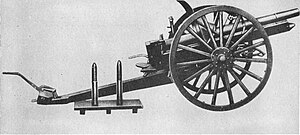Type 38 75 mm Field Gun
| Type 38 75 mm Field Gun | |
|---|---|

Side view of the Type 38 with its ammunition
|
|
| Type | Field gun |
| Place of origin |
|
| Service history | |
| In service | 1905-1945 |
| Used by |
|
| Wars |
World War I Second Sino-Japanese War Soviet-Japanese Border Wars World War II |
| Production history | |
| Designer | Krupp |
| Manufacturer | Osaka Arsenal |
| No. built | ~3,059 all types. |
| Variants | Type 38 (improved) |
| Specifications | |
| Weight | 947 kilograms (2,088 lb) (Type 38) 1,135.7 kilograms (2,504 lb) (Improved Type 38) |
| Length | 5.2 m (17 ft 1 in) (Firing) 8.94 m (29 ft 4 in) (Traveling) |
| Barrel length | 2.286 metres (7 ft 6 in) L/31 |
| Width | Track 4 ft 6 in (1.37 m) Maximum. 5 ft 2 in (1.57 m) |
| Height | 4 ft 10 in (1.47 m) |
|
|
|
| Shell | 6 kilograms (13 lb) |
| Caliber | 75 mm (2.95 in) |
| Breech | interrupted screw (Type 38) horizontal sliding wedge (Improved Type 38) |
| Recoil | hydro-spring |
| Carriage | fixed trail |
| Elevation | -8° to +16° 30' (Type 38) -8° to +43° (Improved Type 38) |
| Traverse | 3°30' right, 3°30' left |
| Rate of fire | 2 minutes 15 rpm 15 minutes 4 rpm Continuous 100-120 rph |
| Muzzle velocity | 510 m/s (1,673 ft/s) |
| Effective firing range | 8,350 metres (9,130 yd) (Type 38) |
| Maximum firing range | 11,600 metres (12,700 yd) (Improved Type 38) |
| Feed system | Hand |
| Sights | Panoramic |
The Type 38 75 mm Field Gun (三八式野砲 Sanhachi-shiki yahō?) was a 1905 German design which was purchased by the Empire of Japan as the standard field gun of the Imperial Japanese Army at the end of the Russo-Japanese War. The Type 38 designation was given to this gun as it was accepted in the 38th year of Emperor Meiji's reign (1905).
Although Japan had extensive experience with artillery, as the result of its war with Russia in 1904-05, and had the technology and industrial infrastructure to construct medium or large caliber naval weapons prior to World War I, planners at the Imperial Japanese Army General Staff turned to Krupp in Germany, for the latest trend in artillery design. Initial units of Krupp 7.5 cm Model 1903 were imported, and then eventually over 2000 units, which were designed "Type 38" in Japan, were produced under license by the Army’s Osaka Arsenal.
The original Type 38 gun had a conical interrupted-thread breech, a single box type trail which limited gun elevation to only 16°30'. Also, there were no equilibrators as the trunnions were at the gun barrel's center of balance. All of these shortcomings were remedied with a redesign following World War I.
After World War I, these weapons were considered largely obsolete. However, by this time, Japanese production capabilities had improved, and the Type 38 underwent a re-design in Japan to improve the carriage, with a corresponding increase in elevation, range and rate of fire to 10-12 rounds per minute.
...
Wikipedia
